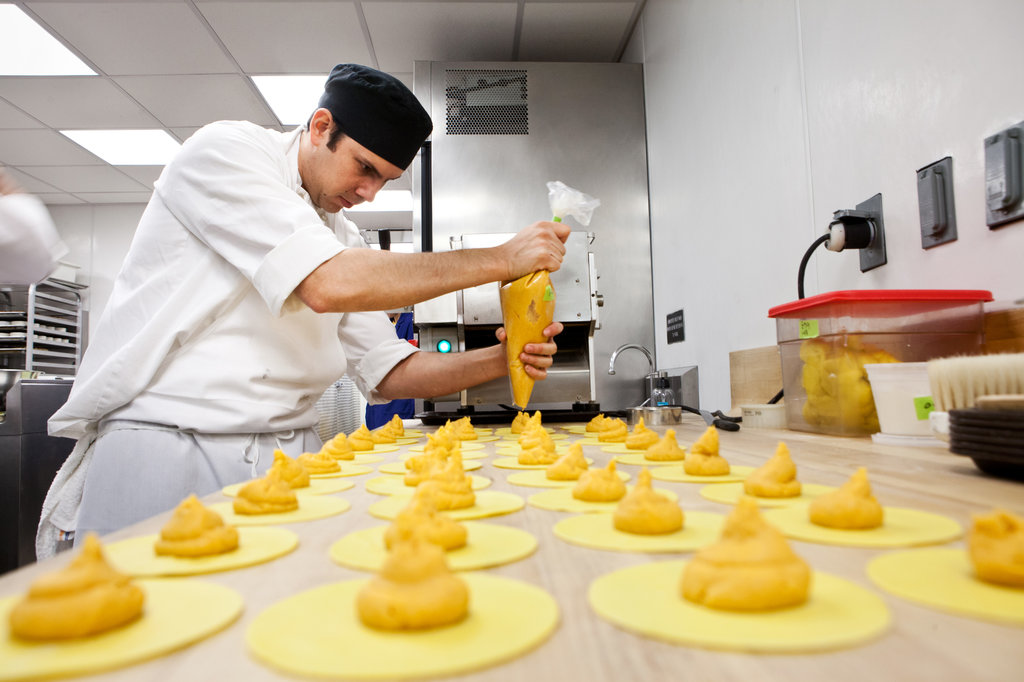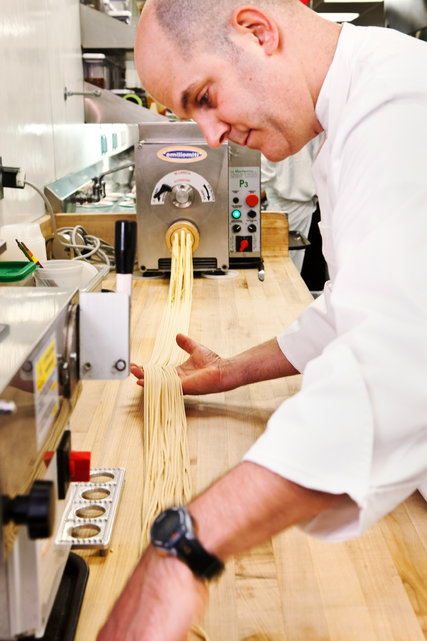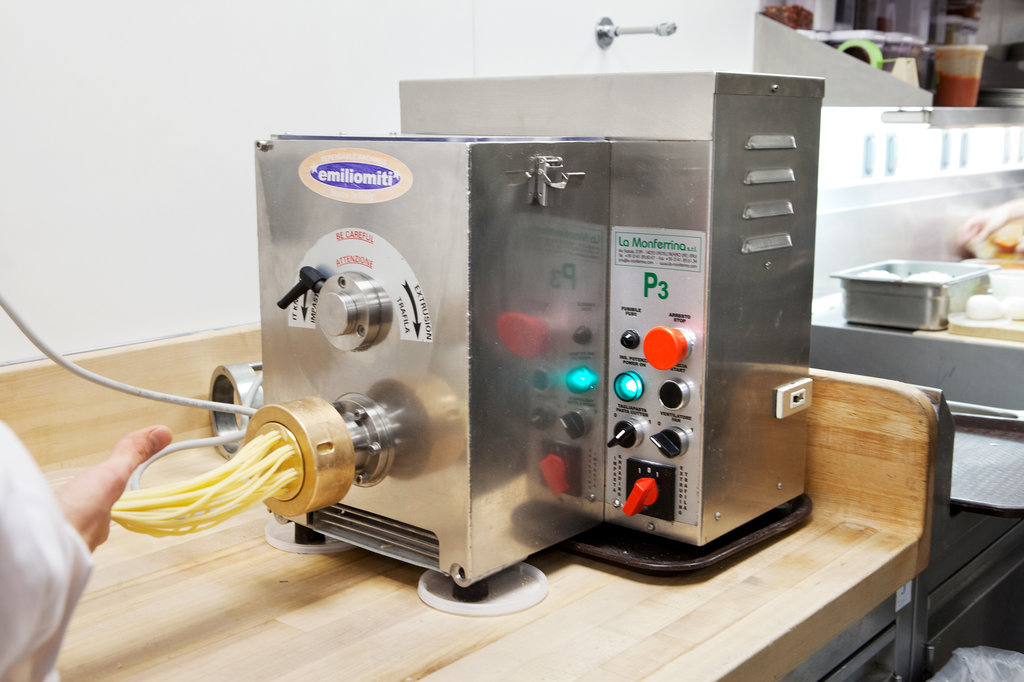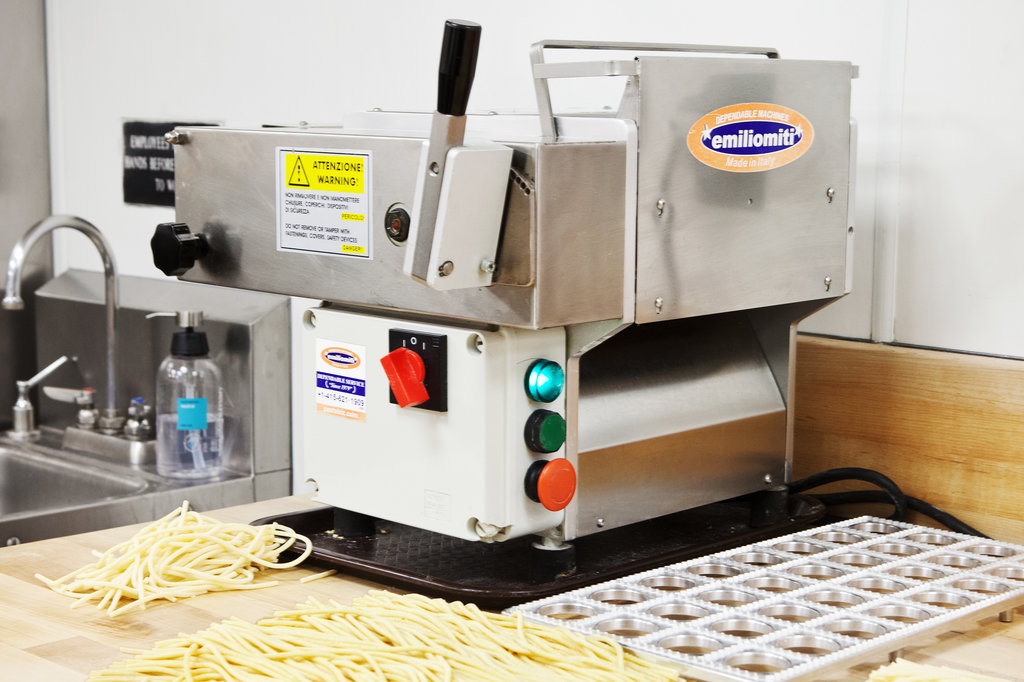NEW YORK TIMES
Pasta With a Perfectionist’s Touch
By NICK CZAP, April 1, 2013

Julio Cardenes makes sweet potato casonsei. Credit Tony Cenicola/The New York Times
SAN FRANCISCO — In 2010, as the chef Jonathan Benno was creating the menu for Lincoln Ristorante in New York, he found himself with a culinary challenge. Lincoln had a prime location on the campus of Lincoln Center and a striking custom-designed building. But Mr. Benno felt a certain pressure to distinguish his project from an increasingly crowded field.
“Look at all of the new Italian restaurants that are getting attention in New York and Brooklyn,” he said. “It’s staggering. You can’t keep up with it.” Under such circumstances, he said, a chef has to ask, “What’s going to make us special?”
A friend of Mr. Benno’s, the chef Michael White, had an idea: fresh pasta. Prepared properly, house-made pasta has a luxuriously silky, creamy texture and a springy bite quite different from that of dried pasta cooked al dente. And despite all the effort, it can be a time saver.
“It takes a minute to cook,” Mr. White said. “If you were cooking dry pasta to order, it’s at least seven or eight minutes. When you’re trying to choreograph that in the kitchen, pasta and different appetizers, it’s very hard to do with dry pasta.”

At Lincoln Ristorante at Lincoln Center, the chef, Jonathan Benno, makes spaghettoni. Credit Tony Cenicola/The New York Times
As for how Mr. Benno could take on the task of making his own, Mr. White had a second suggestion: call Emilio.
Mr. Benno was soon on the phone with Emilio Mitidieri, an entrepreneur who has carved out a lucrative niche over the last three decades by equipping Italian restaurants with the means of manufacturing their most crucial ingredient.
Last year, Mr. Mitidieri’s company here, Emiliomiti, did $1.6 million in business, importing and selling machinery from a number of Italian manufacturers. His customers include some of the nation’s most acclaimed restaurants, like Maialino and Il Buco Alimentari e Vineria in New York and Flour & Water, SPQR and Locanda in San Francisco.
On a recent morning, Mr. Mitidieri — a youthful 61, nattily dressed in a porkpie hat, tweed jacket and a butterfly-bedecked scarf — gave a tour of his showroom and warehouse here in the Mission District. After explaining the inner workings of complex contraptions, including a hulking 1980s-vintage tortellini maker whose metal fingers replicate the movements perfected by countless Italian grandmothers, he emphasized that his company was not merely in the business of selling, but of matching equipment to each restaurant’s needs.
“We have a lot of questions for the client,” he said. “A kid called me yesterday and had no clue — said he wanted to make ‘noodles.’ I had a long conversation to educate him, but he didn’t have time to listen to me.”

The fresh pasta is made in machines imported from Italy by Emilio Mitidieri.
Considering Mr. Mitidieri’s expertise, aspiring pastaios would do well to heed his advice. The Brazilian-born son of parents from Calabria, Italy, Mr. Mitidieri immigrated to San Francisco in 1967. He studied business, immersed himself in the city’s Italian community and in 1978 took a job at a North Beach ravioli factory, where he mastered the intricacies of mechanized pasta production. Later that year, he took what proved to be an influential sabbatical.
“I went to Italy for a couple of weeks and stayed nine months,” he said. “I went to a lot of pasta machine factories, learned about the machines, how they made them, who they make them for and how they did business.”
On returning to California in 1979, Mr. Mitidieri got word that Ciao, a San Francisco restaurant, was looking to buy a tortellini maker and a ravioli maker for its open kitchen. He drew on his connections in Italy, and brokered his first sale. In the 34 years since, he said, he has outfitted nearly 1,000 restaurants with pasta machines.
Mr. Mitidieri sells equipment to pasta factories, some of which he first assisted decades ago when they were small start-ups. He anticipates that this part of the business will continue to grow, propelled by increasing demand for organic, gluten-free and other specialty pastas.
He also works directly with manufacturers to develop custom machinery for clients like the British department store chain Marks & Spencer, which is outfitting its food halls with fresh pasta bars. Most of his clients, though, are chefs seeking to set themselves apart from the pack and capitalize on the cachet of all things house-made.

The fresh pasta is made in machines including one for making extruded pasta, shown here. Credit Tony Cenicola/The New York Times
Mr. White, who oversees what he describes as “a serious fresh pasta program” at Marea and several other restaurants in his Altamarea Group, said: “I only do fresh pasta. Once you start that precedent, there’s no going back.”
But he always goes back to Mr. Mitidieri.
“His service and troubleshooting is fantastic,” he said.
At Lincoln, Mr. Benno invested in two machines after conferring with Mr. Mitidieri: a La Monferrina P3, an extruder, which forces dough through interchangeable metal dies to produce everything from strait-laced rigatoni to the corkscrew spirals of fusilli to the sauce-catching fins of radiatori; and a La Monferrina Nina, a sheeter, which rolls out thin sheets of dough that can be transformed into flat pastas like fettuccine or stuffed varieties like tortellini or cappelletti.
At Lincoln, Mr. Benno invested in two machines after conferring with Mr. Mitidieri: a La Monferrina P3, an extruder, which forces dough through interchangeable metal dies to produce everything from strait-laced rigatoni to the corkscrew spirals of fusilli to the sauce-catching fins of radiatori; and a La Monferrina Nina, a sheeter, which rolls out thin sheets of dough that can be transformed into flat pastas like fettuccine or stuffed varieties like tortellini or cappelletti.
As is his practice with new clients, Mr. Mitidieri spent two days in Lincoln’s kitchen, advising as Mr. Benno put the machines, which cost $3,200 and $3,500 each, through their paces.
“Emilio had a lot of recommendations and tips for technique,” Mr. Benno said. “To this day, if a recipe’s not right, we’ll call him.”

Here, a machine for making sheet pasta. Mr. Mitidieri has also invented a pasta extruder that bolts onto a Hobart mixer. Credit Tony Cenicola/The New York Times
Today, the ease with which the chef discusses the ins and outs of pasta production makes him sound like the foreman of a small factory, which is not far off the mark: many days some 25 pounds of dough run through the machines to create the many varieties of pasta on the menu.
Mr. Benno pointed out that the outlay for a kilogram of raw ingredients — flour and a splash of water or eggs — is a small fraction of the cost of a kilogram of high-quality imported pasta. But production has its own expenses: the price of the machines, training and daily labor. Those costs, in turn, appear to be made up at the restaurant’s cash register: Lincoln charges $24 for a plate of sweet potato casonsei; Marea asks $25 for ricotta ravioli with pesto.
But the average diner need not abandon hope. Mr. Mitidieri has been putting the finishing touches on an invention that he believes will make pasta-making more attractive to lower-end restaurateurs.
“Ninety-seven percent of the restaurant industry wouldn’t consider having a pasta machine, because they buy prepared pasta, or they seem intimidated by the machine,” he said, “but they all have a Hobart,” referring to the burly commercial mixer.
Sensing an untapped market, Mr. Mitidieri enlisted a machinist in Italy to develop a compact extruder and a sheeter that bolt onto a Hobart’s accessory socket. Capable of doing the work of stand-alone machines costing two-and-a-half times as much, these new devices may prove to be his silver (or in this case, stainless steel) bullet.
“When they see it, they’ll buy it,” he said. “I showed it to some chefs, and it blew their minds.”
A version of this article appears in print on April 3, 2013, on Page D2 of the New York edition with the headline: Pasta With a Perfectionist’s Touch.
